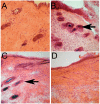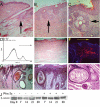Wnt signaling induces epithelial differentiation during cutaneous wound healing
- PMID: 16426441
- PMCID: PMC1388211
- DOI: 10.1186/1471-2121-7-4
Wnt signaling induces epithelial differentiation during cutaneous wound healing
Abstract
Background: Cutaneous wound repair in adult mammals does not regenerate the original epithelial architecture and results in altered skin function. We propose that lack of regeneration may be due to the absence of appropriate molecular signals to promote regeneration. In this study, we investigated the regulation of Wnt signaling during cutaneous wound healing and the consequence of activating either the beta-catenin-dependent or beta-catenin-independent Wnt signaling on epidermal architecture during wound repair.
Results: We determined that the expression of Wnt ligands that typically signal via the beta-catenin-independent pathway is up-regulated in the wound while the beta-catenin-dependent Wnt signaling is activated in the hair follicles adjacent to the wound edge. Ectopic activation of beta-catenin-dependent Wnt signaling with lithium chloride in the wound resulted in epithelial cysts and occasional rudimentary hair follicle structures within the epidermis. In contrast, forced expression of Wnt-5a in the deeper wound induced changes in the interfollicular epithelium mimicking regeneration, including formation of epithelia-lined cysts in the wound dermis, rudimentary hair follicles and sebaceous glands, without formation of tumors.
Conclusion: These findings suggest that adult interfollicular epithelium is capable of responding to Wnt morphogenic signals necessary for restoring epithelial tissue patterning in the skin during wound repair.
Figures



References
Publication types
MeSH terms
Substances
Grants and funding
LinkOut - more resources
Full Text Sources
Other Literature Sources

